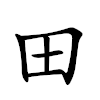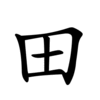田
| ||||||||
| ||||||||
Translingual
| Stroke order (Chinese) | |||
|---|---|---|---|
 | |||
| Stroke order (Japan) | |||
|---|---|---|---|
 | |||
Han character
田 (Kangxi radical 102, 田+0, 5 strokes, cangjie input 田 (W), four-corner 60400, composition ⿴囗十)
- Kangxi radical #102, ⽥.
Derived characters
References
- KangXi: page 756, character 11
- Dai Kanwa Jiten: character 21723
- Dae Jaweon: page 1167, character 1
- Hanyu Da Zidian (first edition): volume 4, page 2524, character 1
- Unihan data for U+7530
Chinese
Glyph origin
| Historical forms of the character 田 | ||||||
|---|---|---|---|---|---|---|
| Shang | Western Zhou | Warring States | Shuowen Jiezi (compiled in Han) | Liushutong (compiled in Ming) | ||
| Bronze inscriptions | Oracle bone script | Bronze inscriptions | Chu slip and silk script | Qin slip script | Small seal script | Transcribed ancient scripts |
 |
 |
 |
 |
 |
 |
 |
Pictogram (象形) – pictographic representation of a field.
Etymology 1
| simp. and trad. |
田 | |
|---|---|---|
From Proto-Sino-Tibetan *b-liŋ (“field”). Cognate with Tibetan ཞིང (zhing, “field; realm”), Jingpho maling (mă³¹ liŋ³³, “forest”).
Pronunciation
Definitions
田
Synonyms
- (farmland):
Compounds
|
|
|
Descendants
Etymology 2
| simp. and trad. |
田 | |
|---|---|---|
| alternative forms | 塍 堘 | |
The Min native word for “paddy field; field”.
Etymology unknown. Chinese scholars identify 塍 (OC *ɦljɯŋ, “raised path between fields”) as the etymological character (本字), although Norman proposes that this is related to 層 (OC *zɯːŋ, “layer”), reflecting the terraced fields commonly found in Fujian (Schuessler, 2007). Compare also 㽪 (“wet field”).
Pronunciation
Compounds
Japanese
Readings
Usage notes
Note that the rice paddy meaning is specific to Japanese. The Chinese word for rice paddy is 水田 (shuǐtián).
Etymology 1
| Kanji in this term |
|---|
| 田 |
| た Grade: 1 |
| kun’yomi |
From Old Japanese. Appears in the Kojiki written in roughly 711-712.[1]
Usage notes
The term ta can refer to either a wet field as for rice agriculture, or a dry field as for other crops. This term does not refer to a wild field or meadow (see 野原 (nohara), 原っぱ (harappa), 草原 (sōgen)).
Derived terms
References
Etymology 2
| Kanji in this term |
|---|
| 田 |
| でん Grade: 1 |
| on’yomi |
Korean
Etymology
From Middle Chinese 田 (MC den).
| Historical Readings | ||
|---|---|---|
| Dongguk Jeongun Reading | ||
| Dongguk Jeongun, 1448 | 뗜 (Yale: ttyèn) | |
| Middle Korean | ||
| Text | Eumhun | |
| Gloss (hun) | Reading | |
| Hunmong Jahoe, 1527 | 받 (Yale: pàt) | 뎐 (Yale: tyèn) |
Pronunciation
- (SK Standard/Seoul) IPA(key): [t͡ɕʌ̹n]
- Phonetic hangul: [전]